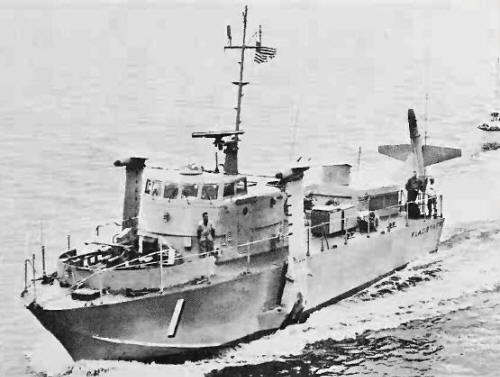

Flagstaff 1968
|
Names |
PGH1, 11.1974- WPBH1, 2.1975- PGH1, 9.1976- WPBH1 Flagstaff |
|
Builders |
Grumman, Stuart: PGH1 Flagstaff |
|
Commissioned |
9/1968: PGH1 Flagstaff |
|
Losses |
none |
|
Transfers |
none |
|
Discarding |
9.1978: WPBH1 Flagstaff |
|
Displacement standard, t |
57 |
|
Displacement full, t |
67 |
|
Length, m |
22.7 |
|
Breadth, m |
6.50 |
|
Draught, m |
4.10 (foils extended) / 1.30 (foils retracted) |
|
No of shafts |
1 shaft (for foil-borne) / 2 water-jets (for hull-borne) |
|
Machinery |
CODOG: 1 Rolls-Royce Tyne gas turbine (foil-borne) / 2 General Motors diesels (hull-borne) |
|
Power, h. p. |
3620 / 300 |
|
Max speed, kts |
48 / 8 |
|
Fuel, t |
diesel oil |
|
Endurance, nm(kts) |
|
|
Armament |
1 x 1 - 40/60 Mk 3, 2 x 2 - 12.7/90, 1 x 1 - 81/12 M29 mortar |
|
Electronic equipment |
radar |
|
Complement |
13 |
Project history: By the early 1960s interest had shifted towards the fast gunboat role, and it appeared that a relatively small hydrofoil could duplicate many of the qualities of the larger Asheville class fast gunboat. Two competitive prototypes were built under the FY66 (SCB 252) programme; the Grumman Flagstaff and the Boeing Tucumcari. At one time a follow-on class of thirty-four hydrofoils was planned, with features borrowed from both. They differed largely in propulsion, Grumman using a geared propeller with the main lifting surface forward; Boeing, water-jets with the main foil surfaces aft. Both were tested in Vietnam, returning home in 1970. Originally armed with 40mm gun forward.
Modernizations: 1971 (temporarily for tests): - 1 x 1 - 40/60; + 1 x 1 -152/12 M81E1 tank gun
1974: armament consisted from small arms only
Naval service: Flagstaff was badly damaged in collision with a whale and was sold in 1978.

Flagstaff 1970, foils retracted
© Ivan Gogin, 2015